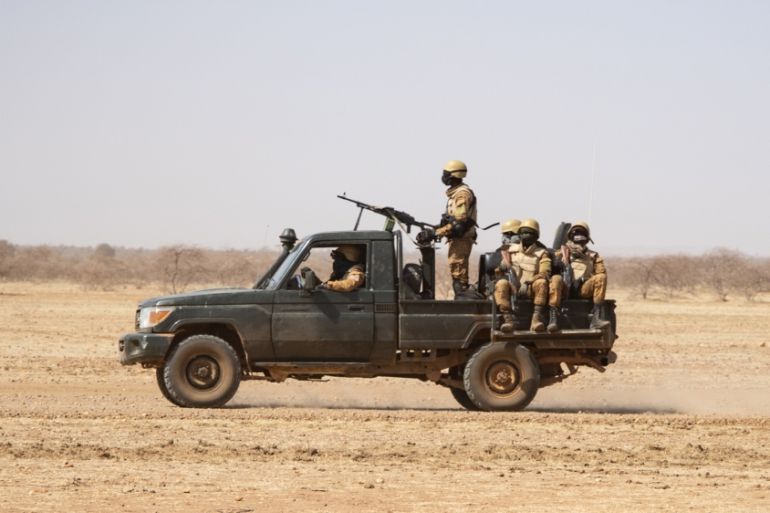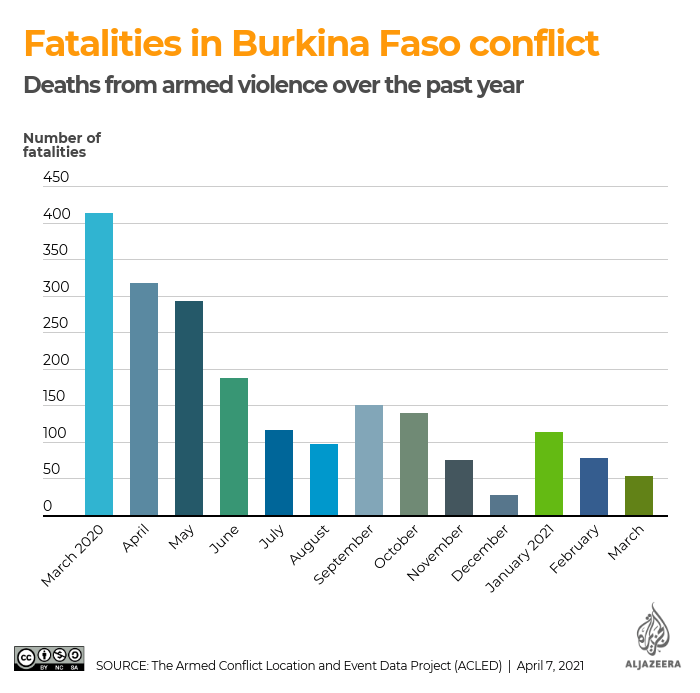What is behind the sharp drop in deaths in Burkina Faso’s war?
The decline in conflict-related fatalities raises many questions, especially since the number of attacks against civilians, battles between armed actors and other acts of violence has remained the same.

Ouagadougou, Burkina Faso – For months, Belko Dialo’s* hometown of Djibo in the restive north of Burkina Faso was blockaded by armed groups that largely cut off its connection with the capital, Ouagadougou.
But in recent weeks, there have been reports that negotiations between the government and the groups have led to a detente between the two sides and the surrender of some 50 fighters.
Keep reading
list of 4 itemsBurkina Faso president says security priority after swearing-in
What next for conflict-hit Burkina Faso after Kabore re-election?
Burkina Faso president Kabore re-elected in landslide victory
Dialo, however, said this has not brought with it a new sense of peace for Djibo’s roughly 60,000 residents.
“I don’t know if there has been a negotiation, because we still can’t go to the [armed group-controlled] areas around here,” the 61-year-old told Al Jazeera on the phone.
“Today, if I told you I can go 5km (3 miles) north of Djibo safely, I’d be lying. Honestly, I don’t see how negotiations can have taken place.”
Nonetheless, Dialo conceded that some of the fighters from the surrounding area have surrendered and that supplies are flowing into the town again. He also said fighters who are still actively battling in the town’s surrounding area now venture into its market unarmed. “Every Wednesday,” to buy food, Dialo said. They are allowed to leave, unhindered by security forces.
Fatalities down
Dialo’s uneasiness and fear of further violence seem to be shared by many Burkinabes in conflict-hit areas, even as statistics show the country’s half-decade war has become significantly less deadly in the last year.
Since March 2020, the number of fatalities in Burkina Faso’s conflict with the Islamic State in the Greater Shara (ISGS), Jama’at Nasr al-Islam wal Muslimin (JNIM) and other armed groups has declined by almost 87 percent – from 413 in March 2020 to just 41 in March 2021 – according to data from the Armed Conflict Location and Event Data Project (ACLED).
Conflict-related deaths in the provinces surrounding Djibo fell to 439 in the past six months, from 901 in the previous six.
This sharp drop-off raises many questions, especially since the number of attacks against civilians, battles between armed actors, and other acts of violence has remained the same.
If attacks are still happening just as often, why are fewer people dying?
While the trend appears to coincide with the outbreak of the coronavirus pandemic last year, analysts and experts said COVID-19 has not been a factor.
The reported negotiations seem to have played a role, with both ACLED analyst Heni Nsaibia and security analyst Mahamadou Sawadogo saying there are indications such talks could be happening in areas of the country other than Djibo – although this has yet to be verified.
The government, however, is reluctant to acknowledge negotiating with the fighters. Military donors, including France, refuse to do so and frown upon allies that engage as such.
Meanwhile, the analysts Al Jazeera spoke to agreed that international military efforts in the tri-border region – a violence hot spot where the frontiers of Burkina Faso, Mali and Niger converge – have also had an effect in reducing fatalities.
Operation Barkhane, the French military initiative in the region, has carried out a number of successful air attacks and secured multiple tactical victories against armed groups in the region over the past year.
There has been collateral damage, however. Last week, a United Nations report said a French aerial assault in January at a wedding party in central Mali had killed 19 unarmed civilians and could amount to a war crime. France rejected the findings but incidents like these often drive recruitment for the armed groups.
Asked about the decline in fatalities, Lassane Sawadogo, executive secretary of Burkina Faso’s ruling People’s Movement for Progress party (MPP), referred to the “national and international efforts to combat terrorism”, arguing the performance of Burkina Faso’s Defense and Security Forces (FDS) has improved “both operationally and in its use of intelligence”.
“There is also the participation of volunteer citizens in the conflict, including the Volunteers for the Defence of the Homeland (VDPs) and the Koglweogo [a local vigilante group],” he told Al Jazeera.
Created in February 2020, the VDPs have been a controversial addition to Burkina Faso’s strategy in the battle against armed groups.
Armed by the government, the civilians comprising the VDPs were given two weeks of training before being sent out to the bush to join the fight. Human rights groups warned early on the that creation of the VDPs would increase violence against civilians, and since then there have been multiple unverified reports of VDPs committing atrocities against civilians.
Still, Mahamadou Sawadogo, the Burkinabe security analyst, said that “in some areas, the VDPs have played a role in reducing violence.”
“When we counted the number of attacks in the Centre North region, there were 180 in 2019 – that decreased to 96 in 2020,” he said. “This is mainly linked to the VDPs with the help of the FDS.”
Nsaibia added that a change in tactics by the armed forces also accounted for the drop.
“Concentrating more military camps, concentrating forces at military camps in larger towns and also by patrolling less, i.e. by being less mobile are major factors,” he said. “As a result, [the FDS] record fewer losses.”
Another factor cited by experts to explain the drop in fatalities is the conflict that broke out last year between JNIM and ISGS, the two main armed groups that are active in Burkina Faso
Nsaibia called the descent into open warfare between the groups an “important dynamic that has weakened the insurgency”.
“The intra-jihadi fighting has been costly in both resources and manpower and exposed the jihadis to increased surveillance and air strikes,” he said.
But Nsaibia also stressed that a drop in fatalities does not necessarily represent success on the part of the military effort, but rather acceptance of a status quo, where large areas of the country are cut off from the state.
By necessity, the FDS is retreating from its more aggressive tactics of previous years, while the armed groups do not have to employ such violent means to maintain control of their territory.
“A live-and-let-live situation between militants and security and defence forces has existed for quite a while now,” he said.
“In many areas under jihadi control or influence, these groups seek to sustain compliance and regulate social behaviour through less violent means, including intimidation by threats, beatings and abductions.”
*Name has been changed for fear of reprisals.